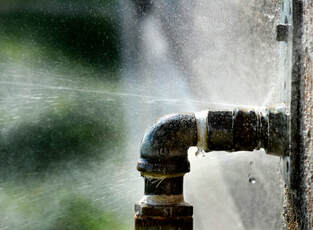We have found this great article relating to Leaking water lines listed below on the net and felt it made perfect sense to write about it with you on this site.

The moment you discover a leakage, calling your plumber for repair services is the very best remedy. Some little water leakages may not be visible. If you can not find it with your naked eyes, here are some hacks that aid.
Early discovery of leaking water lines can minimize a prospective disaster. In addition to saving you cash, it will lessen the stress and stress.
Check Water Consumption
Assess your water bills and also track your water intake. As the one paying it, you need to see if there are any disparities. If you spot sudden changes, in spite of your consumption being the same, it means that you have leaks in your plumbing system. Bear in mind, your water costs must fall under the exact same range each month. An abrupt spike in your bill indicates a fast-moving leakage.
Meanwhile, a consistent rise each month, even with the very same practices, shows you have a slow-moving leakage that's also gradually escalating. Call a plumber to completely inspect your residential property, specifically if you feel a cozy area on your flooring with piping underneath.
Check and also Examine the Circumstance
Home owners must make it a practice to examine under the sink counters and also even inside closets for any type of bad odor or mold and mildew growth. These two red flags show a leak so timely focus is called for. Doing regular assessments, even bi-annually, can save you from a major problem.
Analyze the Water Meter
Checking it is a proven way that assists you uncover leakages. If it moves, that indicates a fast-moving leakage. This means you might have a slow leak that might even be underground.
Asses Exterior Lines
Don't neglect to check your outdoor water lines too. Ought to water seep out of the link, you have a loose rubber gasket. One little leakage can squander loads of water and also spike your water costs.
Do a Food Coloring Examination
When it concerns water intake, 30% comes from commodes. Test to see if they are running correctly. Drop flecks of food color in the storage tank and also wait 10 mins. If the shade somehow infiltrates your bowl during that time without flushing, there's a leakage between the tank and dish.
If you understand your residence is currently old, maintain a careful eye on your heating systems, hose pipes, pipelines etc. Look for discolorations as well as damaging as many home appliances and pipes have a life expectancy. They will likewise normally wear away as a result of tear as well as wear. Don't wait for it to rise if you presume dripping water lines in your plumbing system. Call an expert plumber right away so you don't wind up with an awful mess in your house.
The minute you discover a leak, calling your plumber for repair work is the best service. Some tiny water leaks might not be visible. Inspecting it is a proven way that assists you find leaks. One small leakage can lose heaps of water and also spike your water expense.
If you presume dripping water lines in your plumbing system, don't wait for it to rise.
How to Know If Your Home Has a Hidden Leak
Water Meter Reveals Inexplicable Water Usage
If you’d like to test whether or not there’s a leak somewhere in your home, you can do this using your water meter. Here is how to conduct the test:
Don’t use any water in your home for at least 30 minutes; this also means not turning on faucets or water-using appliances.
Go outside, and check your water meter for activity.
If your water meter shows that there was activity, even though no one was using any water, this proves that there is a leak in your home.
Visible Mold or Mildew Growth
Leaks behind walls create moist, dark environments that allow mold and mildew to grow and thrive. Eventually, you might see mold growth forming on the wall closest to a hidden leak.
If mold is growing in an area that receives a high amount of moisture, such as a bathroom, it may simply be an indication that better ventilation is needed. However, if you see mold growth on a wall or the ceiling in an area where you would not expect, you probably have a hidden leak.
Musty, Mildew Odor
Sometimes you might not be able to see the mold or mildew that is growing as a result of a leak. However, the smell can give the problem away just as easily. If you catch a whiff of something musty, there’s a good chance that old water is collecting somewhere in your home that you can’t see.
Stained/Warped Walls, Ceilings, or Floors
When your home soaks up water, a variety of red flags can become visible, including ceiling stains, bubbling drywall, warped walls, and sagging floors. While these issues can be caused by excess humidity, they can also be signs that a pipe or plumbing connection has started leaking behind your walls.
Inexplicably High Water Bill
After a while, you get a general sense for what your water bill should be. If you own a pool or sprinkler system, your bill will tend to be higher during summer. However, if you receive a water bill that seems especially high, and you can’t figure out what caused it, then you may have a hidden leak somewhere that’s increasing your bill.
https://www.plumbingjoint.com/blog/2019/july/how-to-know-if-your-home-has-a-hidden-leak/

I am very occupied with Locating water leaks and I am praying you appreciated my entry. Are you aware of someone else who is very much interested in the niche? Please feel free to promote it. I treasure reading our article about Hacks to detect leaks.
Comments on “6 Ways to Find Concealed Water Leakages in Your Residence”